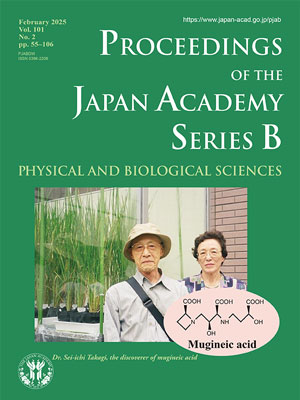About the Cover
Vol. 101 No. 2 (2025)
Mugineic acid is a compound synthesized and secreted by the roots of graminaceous plants in order to efficiently dissolve and absorb iron from the soil. Dr. Sei-ichi Takagi of Tohoku University (later Iwate University) discovered this specific iron uptake mechanism using mugineic acid based on his own observations and first published his findings in Soil Science and Plant Nutrition in 1976.
In this review (pp. 55–67), Dr. Takanori Kobayashi and Dr. Naoko K. Nishizawa introduce a paper on the identification of the chemical structure of mugineic acid, published in Proceedings of the Japan Academy, Series B [Vol. 54, No. 8, pp. 469–473 (1978)] by Dr. Tsunematsu Takemoto and Dr. Kyosuke Nomoto of Tohoku University and their coauthors, including Dr. Sei-ichi Takagi. Mugineic acid and its derivatives, collectively mugineic acid family phytosiderophores (MAs), chelate ferric iron by forming octahedral hexacoordination. The specific iron uptake system by MAs in graminaceous plants was later classified by Röomheld and Marschner as Strategy II, in contrast to Strategy I for reduction-based iron uptake by non-graminaceous plants.
Research on MAs has been performed by many research groups, including the authors’ groups at the University of Tokyo and Ishikawa Prefectural University. The expanding achievements include identification of the biosynthetic pathway of MAs and the corresponding genes and proteins, the molecular mechanism by which plants take up and translocate iron, and the regulatory mechanism of gene expression in response to iron deficiency. These findings also paved the way to wide-ranging applied research. Iron is mostly insoluble in alkaline soils, which account for about 30% of the cultivated area around the world. MAs are effective in iron solubilization even in such soils. Moreover, iron taken up into plants is the major source of iron for humans and animals. Derivatives of MAs were developed as effective iron-supplying materials as fertilizers. Additionally, biotechnological approaches led to the production of crops that grow better in alkaline soils and those accumulating higher amounts of iron in grains.
The cover photograph shows Dr. Sei-ichi Takagi and his wife, Ms. Etsuko Takagi, in front of an isolation greenhouse containing iron deficiency-tolerant rice lines expressing barley nicotianamine aminotransferase genes involved in biosynthesis of MAs, produced by Dr. Michiko Takahashi in the group of Dr. Satoshi Mori and Dr. Naoko K. Nishizawa.
Akira Isogai
Member of the Japan Academy




